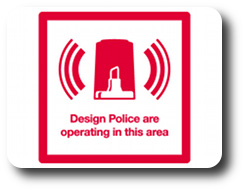Sunday 1 November, 1.45pm until 3.15pm, Student Union
 Forget the police: a new crime-buster is on the block. Designers claim they can lead the charge in the fight against crime. The government backed Design & Technology Alliance Against Crime is leading a programme ‘to develop innovative design solutions to help prevent robbery, to crime-proof hot new gadgets and to embed public safety in the design of new public spaces’. In schools, design ideas are being developed to reduce bullying, fighting and petty theft. Designers are also working on ways to reduce alcohol-related antisocial and criminal behaviour, while materials experts have designed toughened glasses that lessen the damage caused by glassings in bars. Better design can also reduce traffic violations perhaps better than cameras and policing. The Kensington High Street scheme got rave reviews from design bodies when nearly all guard rails and barriers segregating road users from pedestrians were removed, reducing speeding and accidents.
Forget the police: a new crime-buster is on the block. Designers claim they can lead the charge in the fight against crime. The government backed Design & Technology Alliance Against Crime is leading a programme ‘to develop innovative design solutions to help prevent robbery, to crime-proof hot new gadgets and to embed public safety in the design of new public spaces’. In schools, design ideas are being developed to reduce bullying, fighting and petty theft. Designers are also working on ways to reduce alcohol-related antisocial and criminal behaviour, while materials experts have designed toughened glasses that lessen the damage caused by glassings in bars. Better design can also reduce traffic violations perhaps better than cameras and policing. The Kensington High Street scheme got rave reviews from design bodies when nearly all guard rails and barriers segregating road users from pedestrians were removed, reducing speeding and accidents.
We can all benefit from such innovations; who wouldn’t want better bike locks or services like ‘Immobilise’ which allows people to register their valuables and have them returned if stolen? But critics object that many of these initiatives involve manipulating the public to change their behaviour whether they like it or not. When crime-busting features are automatically included in products, clothing and even in neighbourhood layouts, are the public not denied choice?
Designers can’t be blamed for working on lucrative government contracts, but is the ‘design establishment’ compromised by aligning itself with explicitly politicised agendas like ‘the war on crime’? Are designers pandering to panics about rising crime levels where in reality, crime is not escalating, despite the headlines? Is there a danger of turning communities into experimental playgrounds for designers? Or is designing out crime simply an opportunity to improve our lives for the better, and even - to quote the Design Council – ‘stop violence and save lives’?
 | Professor Lorraine Gamman professor, design studies, Central St Martins College of Art and Design, London; director, Design Against Crime Research Centre |
 | Daniel Moylan former deputy chairman of Transport for London; Conservative Councillor; co-chairman, Urban Design London |
 | Martyn Perks digital business consultant and writer; co-author, Big Potatoes: the London manifesto for innovation |
 | Dr Stuart Waiton lecturer in sociology and criminology, Abertay University; author, Snobs' Law: criminalising football fans in an age of intolerance |
| Chair: | |

|
Dolan Cummings
associate fellow, Academy of Ideas; author, That Existential Leap: a crime story (forthcoming from Zero Books) |
 A transparent attempt at social engineering
A transparent attempt at social engineering
Design cannot solve every problem. But if we continue to support this new breed of design police, we may well have to suffer the consequences of their ill-thought-through actions.
Martyn Perks, spiked, 10 September 2009Motorists and pedestrians will be forced to jostle for space under plans being drawn up by councils to strip roads of traffic lights, kerbs and white lines.
Chris Gourlay, The Sunday Times, 6 September 2009'The Design Against Crime Research Centre (DACRC) was set up partly because I took down the life story of Shirley Pitts, a professional shoplifter and was astonished at what I learned - how easy it was to shoplift.'
Carli Pierce, Design21, 3 September 2009CPTED is a crime prevention philosophy based on the theory that proper design and effective use of the built environment can lead to a reduction in the fear and incidence of crime, as well as an improvement in the quality of life.
mesaaz.gov, 2009The Design Council, the Home Office and the Design and Technology Alliance have unveiled a major expansion of the Designing Out Crime initiative.
Design Week, 4 November 2008This thorough, broad and yet detailed approach will help to prevent crime and have a direct impact on the quality of our environment.
Kees Dorst, Curve, July 2008